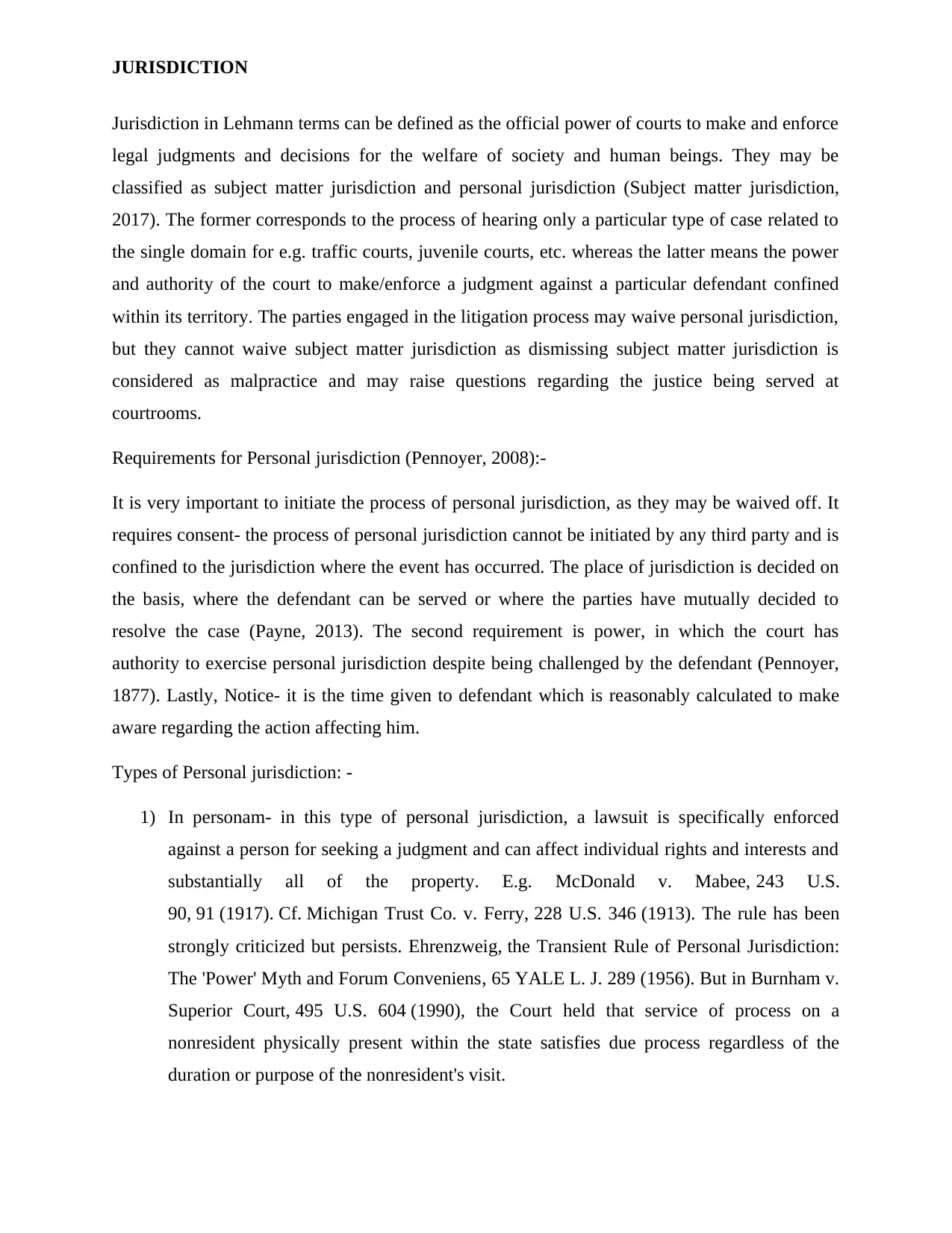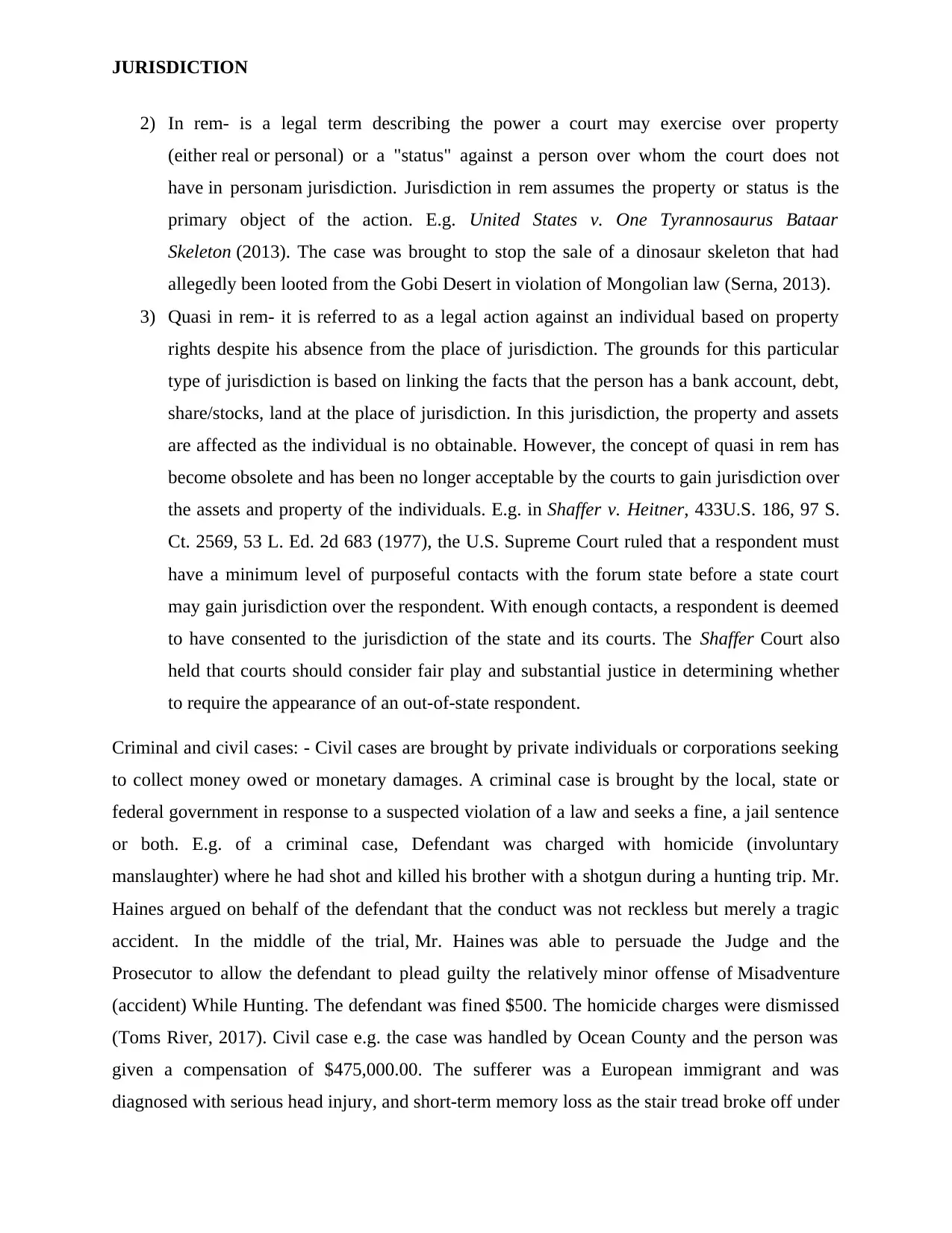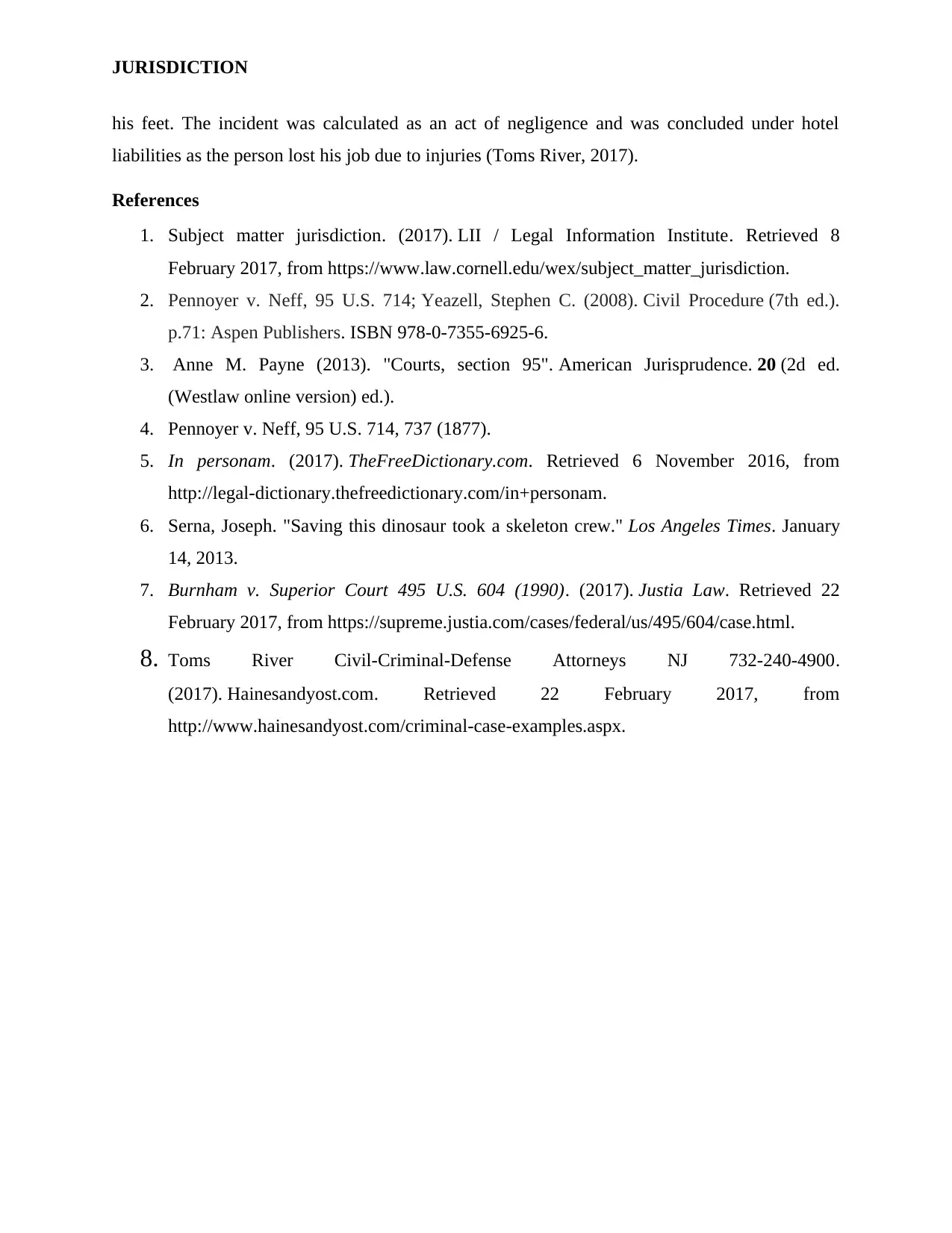Jurisdiction Report
VerifiedAdded on 2019/09/16
|3
|1190
|256
Report
AI Summary
This report provides a comprehensive overview of jurisdiction in law, defining it as the official power of courts to make and enforce legal judgments. It distinguishes between subject matter jurisdiction (the type of cases a court can hear) and personal jurisdiction (the court's power over a specific defendant). The report details the requirements for personal jurisdiction: consent, power, and notice. It then explores three types of personal jurisdiction: in personam (against a person), in rem (against property), and quasi in rem (against property to reach a person). The report explains that quasi in rem jurisdiction has largely become obsolete. Finally, it differentiates between civil and criminal cases, providing examples of each to illustrate the practical application of jurisdictional concepts. The report concludes with a list of references used in its compilation.

JURISDICTION
Jurisdiction in Lehmann terms can be defined as the official power of courts to make and enforce
legal judgments and decisions for the welfare of society and human beings. They may be
classified as subject matter jurisdiction and personal jurisdiction (Subject matter jurisdiction,
2017). The former corresponds to the process of hearing only a particular type of case related to
the single domain for e.g. traffic courts, juvenile courts, etc. whereas the latter means the power
and authority of the court to make/enforce a judgment against a particular defendant confined
within its territory. The parties engaged in the litigation process may waive personal jurisdiction,
but they cannot waive subject matter jurisdiction as dismissing subject matter jurisdiction is
considered as malpractice and may raise questions regarding the justice being served at
courtrooms.
Requirements for Personal jurisdiction (Pennoyer, 2008):-
It is very important to initiate the process of personal jurisdiction, as they may be waived off. It
requires consent- the process of personal jurisdiction cannot be initiated by any third party and is
confined to the jurisdiction where the event has occurred. The place of jurisdiction is decided on
the basis, where the defendant can be served or where the parties have mutually decided to
resolve the case (Payne, 2013). The second requirement is power, in which the court has
authority to exercise personal jurisdiction despite being challenged by the defendant (Pennoyer,
1877). Lastly, Notice- it is the time given to defendant which is reasonably calculated to make
aware regarding the action affecting him.
Types of Personal jurisdiction: -
1) In personam- in this type of personal jurisdiction, a lawsuit is specifically enforced
against a person for seeking a judgment and can affect individual rights and interests and
substantially all of the property. E.g. McDonald v. Mabee, 243 U.S.
90, 91 (1917). Cf. Michigan Trust Co. v. Ferry, 228 U.S. 346 (1913). The rule has been
strongly criticized but persists. Ehrenzweig, the Transient Rule of Personal Jurisdiction:
The 'Power' Myth and Forum Conveniens, 65 YALE L. J. 289 (1956). But in Burnham v.
Superior Court, 495 U.S. 604 (1990), the Court held that service of process on a
nonresident physically present within the state satisfies due process regardless of the
duration or purpose of the nonresident's visit.
Jurisdiction in Lehmann terms can be defined as the official power of courts to make and enforce
legal judgments and decisions for the welfare of society and human beings. They may be
classified as subject matter jurisdiction and personal jurisdiction (Subject matter jurisdiction,
2017). The former corresponds to the process of hearing only a particular type of case related to
the single domain for e.g. traffic courts, juvenile courts, etc. whereas the latter means the power
and authority of the court to make/enforce a judgment against a particular defendant confined
within its territory. The parties engaged in the litigation process may waive personal jurisdiction,
but they cannot waive subject matter jurisdiction as dismissing subject matter jurisdiction is
considered as malpractice and may raise questions regarding the justice being served at
courtrooms.
Requirements for Personal jurisdiction (Pennoyer, 2008):-
It is very important to initiate the process of personal jurisdiction, as they may be waived off. It
requires consent- the process of personal jurisdiction cannot be initiated by any third party and is
confined to the jurisdiction where the event has occurred. The place of jurisdiction is decided on
the basis, where the defendant can be served or where the parties have mutually decided to
resolve the case (Payne, 2013). The second requirement is power, in which the court has
authority to exercise personal jurisdiction despite being challenged by the defendant (Pennoyer,
1877). Lastly, Notice- it is the time given to defendant which is reasonably calculated to make
aware regarding the action affecting him.
Types of Personal jurisdiction: -
1) In personam- in this type of personal jurisdiction, a lawsuit is specifically enforced
against a person for seeking a judgment and can affect individual rights and interests and
substantially all of the property. E.g. McDonald v. Mabee, 243 U.S.
90, 91 (1917). Cf. Michigan Trust Co. v. Ferry, 228 U.S. 346 (1913). The rule has been
strongly criticized but persists. Ehrenzweig, the Transient Rule of Personal Jurisdiction:
The 'Power' Myth and Forum Conveniens, 65 YALE L. J. 289 (1956). But in Burnham v.
Superior Court, 495 U.S. 604 (1990), the Court held that service of process on a
nonresident physically present within the state satisfies due process regardless of the
duration or purpose of the nonresident's visit.
Paraphrase This Document
Need a fresh take? Get an instant paraphrase of this document with our AI Paraphraser

JURISDICTION
2) In rem- is a legal term describing the power a court may exercise over property
(either real or personal) or a "status" against a person over whom the court does not
have in personam jurisdiction. Jurisdiction in rem assumes the property or status is the
primary object of the action. E.g. United States v. One Tyrannosaurus Bataar
Skeleton (2013). The case was brought to stop the sale of a dinosaur skeleton that had
allegedly been looted from the Gobi Desert in violation of Mongolian law (Serna, 2013).
3) Quasi in rem- it is referred to as a legal action against an individual based on property
rights despite his absence from the place of jurisdiction. The grounds for this particular
type of jurisdiction is based on linking the facts that the person has a bank account, debt,
share/stocks, land at the place of jurisdiction. In this jurisdiction, the property and assets
are affected as the individual is no obtainable. However, the concept of quasi in rem has
become obsolete and has been no longer acceptable by the courts to gain jurisdiction over
the assets and property of the individuals. E.g. in Shaffer v. Heitner, 433U.S. 186, 97 S.
Ct. 2569, 53 L. Ed. 2d 683 (1977), the U.S. Supreme Court ruled that a respondent must
have a minimum level of purposeful contacts with the forum state before a state court
may gain jurisdiction over the respondent. With enough contacts, a respondent is deemed
to have consented to the jurisdiction of the state and its courts. The Shaffer Court also
held that courts should consider fair play and substantial justice in determining whether
to require the appearance of an out-of-state respondent.
Criminal and civil cases: - Civil cases are brought by private individuals or corporations seeking
to collect money owed or monetary damages. A criminal case is brought by the local, state or
federal government in response to a suspected violation of a law and seeks a fine, a jail sentence
or both. E.g. of a criminal case, Defendant was charged with homicide (involuntary
manslaughter) where he had shot and killed his brother with a shotgun during a hunting trip. Mr.
Haines argued on behalf of the defendant that the conduct was not reckless but merely a tragic
accident. In the middle of the trial, Mr. Haines was able to persuade the Judge and the
Prosecutor to allow the defendant to plead guilty the relatively minor offense of Misadventure
(accident) While Hunting. The defendant was fined $500. The homicide charges were dismissed
(Toms River, 2017). Civil case e.g. the case was handled by Ocean County and the person was
given a compensation of $475,000.00. The sufferer was a European immigrant and was
diagnosed with serious head injury, and short-term memory loss as the stair tread broke off under
2) In rem- is a legal term describing the power a court may exercise over property
(either real or personal) or a "status" against a person over whom the court does not
have in personam jurisdiction. Jurisdiction in rem assumes the property or status is the
primary object of the action. E.g. United States v. One Tyrannosaurus Bataar
Skeleton (2013). The case was brought to stop the sale of a dinosaur skeleton that had
allegedly been looted from the Gobi Desert in violation of Mongolian law (Serna, 2013).
3) Quasi in rem- it is referred to as a legal action against an individual based on property
rights despite his absence from the place of jurisdiction. The grounds for this particular
type of jurisdiction is based on linking the facts that the person has a bank account, debt,
share/stocks, land at the place of jurisdiction. In this jurisdiction, the property and assets
are affected as the individual is no obtainable. However, the concept of quasi in rem has
become obsolete and has been no longer acceptable by the courts to gain jurisdiction over
the assets and property of the individuals. E.g. in Shaffer v. Heitner, 433U.S. 186, 97 S.
Ct. 2569, 53 L. Ed. 2d 683 (1977), the U.S. Supreme Court ruled that a respondent must
have a minimum level of purposeful contacts with the forum state before a state court
may gain jurisdiction over the respondent. With enough contacts, a respondent is deemed
to have consented to the jurisdiction of the state and its courts. The Shaffer Court also
held that courts should consider fair play and substantial justice in determining whether
to require the appearance of an out-of-state respondent.
Criminal and civil cases: - Civil cases are brought by private individuals or corporations seeking
to collect money owed or monetary damages. A criminal case is brought by the local, state or
federal government in response to a suspected violation of a law and seeks a fine, a jail sentence
or both. E.g. of a criminal case, Defendant was charged with homicide (involuntary
manslaughter) where he had shot and killed his brother with a shotgun during a hunting trip. Mr.
Haines argued on behalf of the defendant that the conduct was not reckless but merely a tragic
accident. In the middle of the trial, Mr. Haines was able to persuade the Judge and the
Prosecutor to allow the defendant to plead guilty the relatively minor offense of Misadventure
(accident) While Hunting. The defendant was fined $500. The homicide charges were dismissed
(Toms River, 2017). Civil case e.g. the case was handled by Ocean County and the person was
given a compensation of $475,000.00. The sufferer was a European immigrant and was
diagnosed with serious head injury, and short-term memory loss as the stair tread broke off under

JURISDICTION
his feet. The incident was calculated as an act of negligence and was concluded under hotel
liabilities as the person lost his job due to injuries (Toms River, 2017).
References
1. Subject matter jurisdiction. (2017). LII / Legal Information Institute. Retrieved 8
February 2017, from https://www.law.cornell.edu/wex/subject_matter_jurisdiction.
2. Pennoyer v. Neff, 95 U.S. 714; Yeazell, Stephen C. (2008). Civil Procedure (7th ed.).
p.71: Aspen Publishers. ISBN 978-0-7355-6925-6.
3. Anne M. Payne (2013). "Courts, section 95". American Jurisprudence. 20 (2d ed.
(Westlaw online version) ed.).
4. Pennoyer v. Neff, 95 U.S. 714, 737 (1877).
5. In personam. (2017). TheFreeDictionary.com. Retrieved 6 November 2016, from
http://legal-dictionary.thefreedictionary.com/in+personam.
6. Serna, Joseph. "Saving this dinosaur took a skeleton crew." Los Angeles Times. January
14, 2013.
7. Burnham v. Superior Court 495 U.S. 604 (1990). (2017). Justia Law. Retrieved 22
February 2017, from https://supreme.justia.com/cases/federal/us/495/604/case.html.
8. Toms River Civil-Criminal-Defense Attorneys NJ 732-240-4900.
(2017). Hainesandyost.com. Retrieved 22 February 2017, from
http://www.hainesandyost.com/criminal-case-examples.aspx.
his feet. The incident was calculated as an act of negligence and was concluded under hotel
liabilities as the person lost his job due to injuries (Toms River, 2017).
References
1. Subject matter jurisdiction. (2017). LII / Legal Information Institute. Retrieved 8
February 2017, from https://www.law.cornell.edu/wex/subject_matter_jurisdiction.
2. Pennoyer v. Neff, 95 U.S. 714; Yeazell, Stephen C. (2008). Civil Procedure (7th ed.).
p.71: Aspen Publishers. ISBN 978-0-7355-6925-6.
3. Anne M. Payne (2013). "Courts, section 95". American Jurisprudence. 20 (2d ed.
(Westlaw online version) ed.).
4. Pennoyer v. Neff, 95 U.S. 714, 737 (1877).
5. In personam. (2017). TheFreeDictionary.com. Retrieved 6 November 2016, from
http://legal-dictionary.thefreedictionary.com/in+personam.
6. Serna, Joseph. "Saving this dinosaur took a skeleton crew." Los Angeles Times. January
14, 2013.
7. Burnham v. Superior Court 495 U.S. 604 (1990). (2017). Justia Law. Retrieved 22
February 2017, from https://supreme.justia.com/cases/federal/us/495/604/case.html.
8. Toms River Civil-Criminal-Defense Attorneys NJ 732-240-4900.
(2017). Hainesandyost.com. Retrieved 22 February 2017, from
http://www.hainesandyost.com/criminal-case-examples.aspx.
⊘ This is a preview!⊘
Do you want full access?
Subscribe today to unlock all pages.

Trusted by 1+ million students worldwide
1 out of 3
Related Documents
Your All-in-One AI-Powered Toolkit for Academic Success.
+13062052269
info@desklib.com
Available 24*7 on WhatsApp / Email
![[object Object]](/_next/static/media/star-bottom.7253800d.svg)
Unlock your academic potential
Copyright © 2020–2025 A2Z Services. All Rights Reserved. Developed and managed by ZUCOL.





